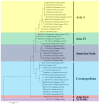Metavirome Analysis and Identification of Midge-Borne Viruses from Yunnan Province, China, in 2021
- PMID: 37766224
- PMCID: PMC10535587
- DOI: 10.3390/v15091817
Metavirome Analysis and Identification of Midge-Borne Viruses from Yunnan Province, China, in 2021
Abstract
Midges are widely distributed globally and can transmit various human and animal diseases through blood-sucking. As part of this study, 259,300 midges were collected from four districts in Yunnan province, China, to detect the viral richness and diversity using metavirome analysis techniques. As many as 26 virus families were detected, and the partial sequences of bluetongue virus (BTV), dengue virus (DENV), and Getah virus (GETV) were identified by phylogenetic analysis and PCR amplification. Two BTV gene fragments, 866 bps for the VP2 gene of BTV type 16 and 655 bps for the VP5 gene of BTV type 21, were amplified. The nucleotide sequence identities of the two amplified BTV fragments were 94.46% and 98.81%, respectively, with two classical BTV-16 (GenBank: JN671907) and BTV-21 strains (GenBank: MK250961) isolated in Yunnan province. Furthermore, the BTV-16 DH2021 strain was successfully isolated in C6/36 cells, and the peak value of the copy number reached 3.13 × 107 copies/μL after five consecutive BHK-21 cell passages. Moreover, two 2054 bps fragments including the E gene of DENV genotype Asia II were amplified and shared the highest identity with the DENV strain isolated in New Guinea in 1944. A length of 656 bps GETV gene sequence encoded the partial capsid protein, and it shared the highest identity of 99.68% with the GETV isolated from Shandong province, China, in 2017. Overall, this study emphasizes the importance of implementing prevention and control strategies for viral diseases transmitted by midges in China.
Keywords: metavirome analyses; midge-borne viruses; phylogenetic analyses; virus identification; virus isolation.
Conflict of interest statement
The authors declare no conflict of interest.
Figures





Similar articles
-
Isolation and Characterization of Getah Virus GD2202 from Mosquitoes in Foshan, China.Vector Borne Zoonotic Dis. 2025 Apr;25(4):269-276. doi: 10.1089/vbz.2024.0100. Epub 2025 Feb 21. Vector Borne Zoonotic Dis. 2025. PMID: 39982270
-
Multiple Novel Mosquito-Borne Zoonotic Viruses Revealed in Pangolin Virome.Front Cell Infect Microbiol. 2022 Jun 29;12:874003. doi: 10.3389/fcimb.2022.874003. eCollection 2022. Front Cell Infect Microbiol. 2022. PMID: 35846764 Free PMC article.
-
[Isolation and identification of Arbovirus in Hainan province, 2017-2018].Zhonghua Liu Xing Bing Xue Za Zhi. 2020 Feb 10;41(2):236-243. doi: 10.3760/cma.j.issn.0254-6450.2020.02.018. Zhonghua Liu Xing Bing Xue Za Zhi. 2020. PMID: 32164136 Chinese.
-
VP2 gene based phylogenetic relationship of Indian isolates of Bluetongue virus serotype 1 and other serotypes from different parts of the world.DNA Seq. 2004 Oct-Dec;15(5-6):351-61. doi: 10.1080/10425170400012941. DNA Seq. 2004. PMID: 15621660
-
Transcriptomic Investigation of the Virus Spectrum Carried by Midges in Border Areas of Yunnan Province.Viruses. 2024 Apr 25;16(5):674. doi: 10.3390/v16050674. Viruses. 2024. PMID: 38793556 Free PMC article.
References
-
- Young P.R. Arboviruses: A Family on the Move. Adv. Exp. Med. Biol. 2018;1062:1–10. - PubMed
Publication types
MeSH terms
Substances
LinkOut - more resources
Full Text Sources
Research Materials

